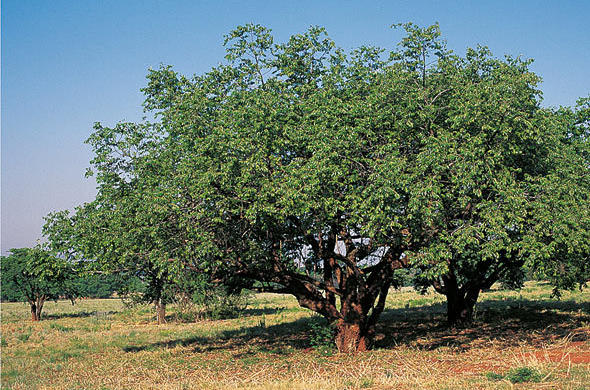Ziziphus mucronata is also known as the buffalo tooth. It is a species in the Rhamnaceae family. It can grow up to 17 metres in height and is deciduous. It is able to survive in many soil types. It thrives in open woodlands and termite mounds. Its Zulu name “umLahlankosi” alludes to its use as a grave marker for tribal chiefs, while the Afrikaans name “Blinkblaar-wag-‘n-bietjie” alludes to the shiny light green leaves and the hooked thorns.


The buffalo thorn can grow to a height of approximately 10 metres (33 feet) or less rarely, 17 metres (56 feet). On young stems, the bark is either a dark brownish-red or a mottled grey. The underbark is revealed when it’s cracked into small blocks. The bark becomes rougher and can turn dark grey or brown. The tree or shrub has distinctive zigzag branches, each with a pair of thorns. One is hooked, the other is straight. Sometimes, adult trees may lose all their thorns. Although the fruit may vary in size, they can grow to be larger than grapes depending on where they are located. They also ripen to deep brown-red colours. The dense clusters of greenish-yellow flowers with a silvery sheen can be found in the axils and leaves from October through April. From February through August, fruit is available.
Because its thorns can be quite dense when young, they are hard to untangle as one point points forward and the other points backward. This makes it a great perimeter barrier. Some tribes believe that the tree can be used as a lightning shelter and may even be planted to mark the grave of a chief who has passed away.
Uses for medical purposes
The roots are used to treat pain and dysentery, while the bark leaves and leaves can be used to treat respiratory conditions and sepsis skin. The roots and leaves can be used to treat sores, boils, and swelling. These symptoms can be attributed to the peptide alkaloids as well as the antifungal that are isolated from the bark or leaves. The branches are used to protect cattle kraal, and sometimes the graves of tribal members who have died. Wood is used as fuel and implement. The bark, roots, and leaves of the trees can be used magically and medicinally to relieve pain and discomforts related to respiratory problems and skin infections. You can stop bleeding by crushing the leaves. To improve and purify the skin, steam baths made from bark can be used. Snake bites can be treated with roots in East Africa.
Uses for nutrition
The leaves can be made into spinach. You can roast the seeds and use them as a substitute for coffee. Although the fruit is not very flavorful, a beer type can be made with them. It is used by Ovambo to make ombike traditional liquor. It is also an excellent source of forage for livestock.


